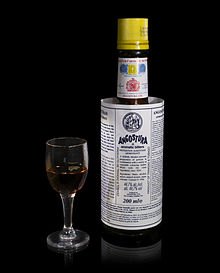Bitters
This article has multiple issues. Please help improve it or discuss these issues on the talk page. (Learn how and when to remove these messages)
No issues specified. Please specify issues, or remove this template. |

A bitters is an alcoholic beverage flavored with herbal essences and has a bitter or bittersweet flavor. Numerous brands of bitters were formerly marketed as patent medicines, but are now considered to be digestifs rather than medicines. They commonly have an alcoholic strength of 45% ABV and are used as digestifs and as flavoring in cocktails.
Ingredients
Common ingredients in bitters include cascarilla, cassia, gentian, orange peel, and quinine from cinchona bark (grown in Peru and Indonesia). The flavor of Angostura bitters, Suze and Peychaud's Bitters derives primarily from gentian, a bitter herb. Bitters are prepared by infusion or distillation, using aromatic herbs, bark, roots, and/or fruit for their flavor and medicinal properties.
In Foundations of Health, Christopher Hobbs, LAc, AHG lists angelica root (A. archangelica), artichoke leaf (Cynara scolymus), bitter orange peel (Citrus aurantium), blessed thistle leaves (Cnicus bendicutus), gentian root (Gentiana lutea), goldenseal rhizome (Hydrastis canadensis), wormwood leaves (Artemisia absinthium) and yarrow flowers (Achillea millefolium) as typical contents of bitters formulas.
History

Angostura bitters was first compounded in Venezuela in 1824 by German physician Dr. Johann Gottlieb Benjamin Siegert; it was compounded as a cure for sea sickness and stomach maladies, though other medicinal uses had been discovered long before this.[1] Dr. Siegert subsequently formed the House of Angostura, a company selling the bitters to sailors.
It was exported to England and to Trinidad, where it came to be used in a number of cocktails, following its medicinal use by the Royal Navy in Pink Gin. Angostura and similar gentian bitters can be of some value for settling a mild case of nausea. It is used to stimulate the appetite, either for food or for cocktails. Used in both apéritifs and digestifs, it settles the stomach before a meal or before a night of drinking.[citation needed]
Angostura bitters was named after the town of Angostura in Venezuela. It contains no angostura bark, a medicinal bark which is named after the same town.
It is used as the "starter" ingredient in a Pink Gin, where a splash (or two) of Angostura bitters is swirled around the inner surface of a tumbler before adding a generous measure of gin. The resulting drink is so named from the color imparted by the bitters. In addition to the options of drinking a Pink straight, it may also be consumed with a little water, still or sparkling. Some Pink Gin drinkers even have preference for drinking it "in" or "out", i.e., leaving in or pouring out the remaining dribble of bitters (after the glass has been "pinked") before the gin is added.[citation needed]
A large tumbler, similarly "pinked" and filled with sparkling lemonade, is a drink known as a Campbell. This is regarded by some as a pleasant and refreshing way to relieve a little of the sweetness of lemonade; the same drink with added lime cordial is called "lemon, lime and bitters" in Australia, and is available both as a mixed drink in bars and as a ready-made bottled soft drink.[2]
Peychaud's Bitters is associated with New Orleans, Louisiana, and the Sazerac cocktail. It is also aromatic, showing subtle cloves and other spices on the nose.
Orange bitters are made from the rinds of Seville oranges, plus spices of varying recipes to enhance the orange flavor. Orange bitters are often called for in older cocktail recipes, which range from aromatic to fruity.
Medicinal quantities of quinine were occasionally used in old cocktail recipes. Quinine is still found in much lower concentrations in tonic water, used today mostly in drinks with gin.
The oldest and rarest of antique bottles command prices of tens of thousands of dollars.[3]
Digestive bitters
Digestive bitters are typically consumed either neat (unadulterated) or with ice at the end of a meal in many European and South American countries. Some, like Fernet Branca or Campari, are regularly used in cocktails, as well.
Some brands of digestive bitters available today are:
|
|
Cocktail bitters

Cocktail bitters are typically used for flavoring cocktails in drops or dashes. In the United States, many cocktail bitters are classified as nonalcoholic beverage products. As such, they are available at stores that do not have licenses to sell liquor, such as supermarkets in many US states. The following producers are available and distributed on essentially a world-wide basis.
Current Pre-Prohibition Producers
- Angostura bitters (originally from Venezuela, currently from Trinidad and Tobago)
- Fee Brothers bitters (aromatic, orange, mint, lemon, rhubarb, cherry and peach), from Rochester, New York; the aromatic bitters contain angostura bark; contains glycerin; most are alcohol free and many contain artificial flavorings
- Peychaud's Bitters (Originally from New Orleans, LA but now produced in Kentucky, United States)
Current Post-Prohibition Producers
- Bittermens (Founded in 2007 in San Francisco - producing in New Orleans since 2013) - flavors include Xocolatl Mole (chocolate spice), Hopped Grapefruit, Burlesque Bitters (hibiscus, açai, quassia), 'Elemakule Tiki Bitters (clove, allspice, cinnamon, citrus) and Boston "Bittahs" (citrus, chamomile)
- Dr. Adam Elmegirab (Scotland) - Bokers Bitters (historical reproduction), Spanish Bitters (Seville orange), Dandelion and Burdock Bitters, Aphrodite Bitters and Teapot Bitters
Regionally Available Bitters
- Appenzeller (from Switzerland)
- Calisaya bitters (containing cinchona/quinine)
- Hartwig-Kantorowicz (from Germany)
- Malört (Swedish-American, Chicago, Illinois)
- Kabänes (from Germany)
- Meinhard's Bitters Dr. Teodoro Meinhard's Angostura Bitters (From Venezuela)
- Meyer's Bitter (from Germany)
- Flimm's (from Germany)
- Reichs-Post Bitter (from Germany)
- The Bitter Truth (from Germany, produced in Austria under license)
- Bittercube (Milwaukee, WI USA)
- The Bitter End (New Mexico, USA)
Nonalcoholic bitters
Although almost all bitters contain alcohol, a few nonalcoholic brands have been produced. Most of them are carbonated:
See also
References
- ^ "Angostura Bitters". Angosturabitters.com. Retrieved 2007-04-29.
- ^ [1][dead link]
- ^ "Antique Bitters Bottles". Antiquebottles-glass.com. 2011-03-25. Retrieved 2012-11-24.
